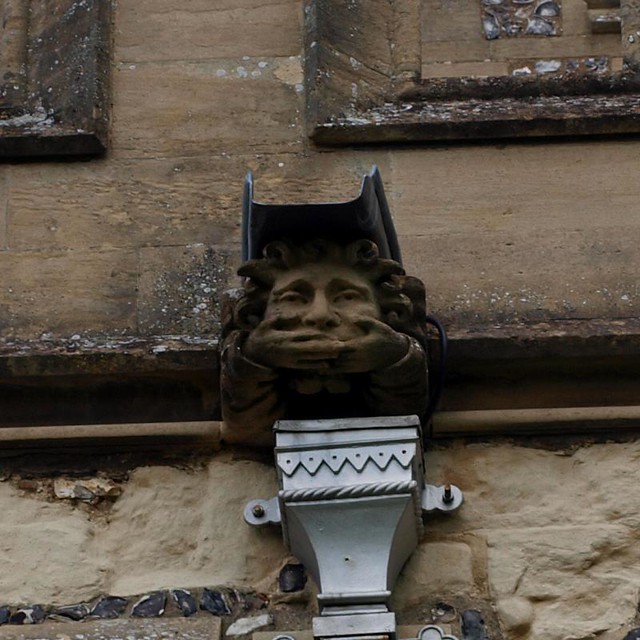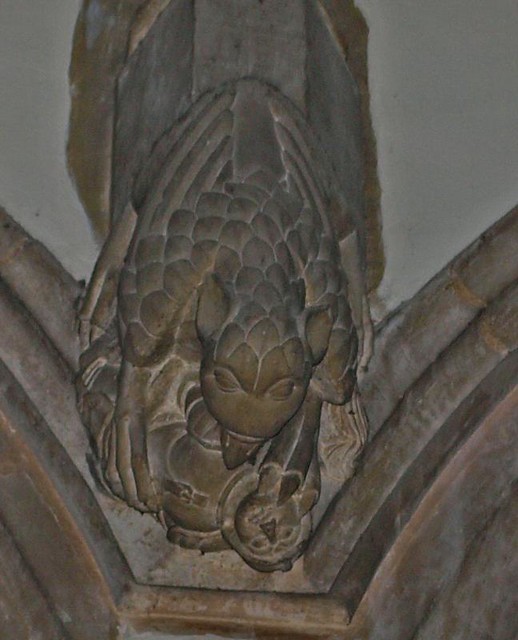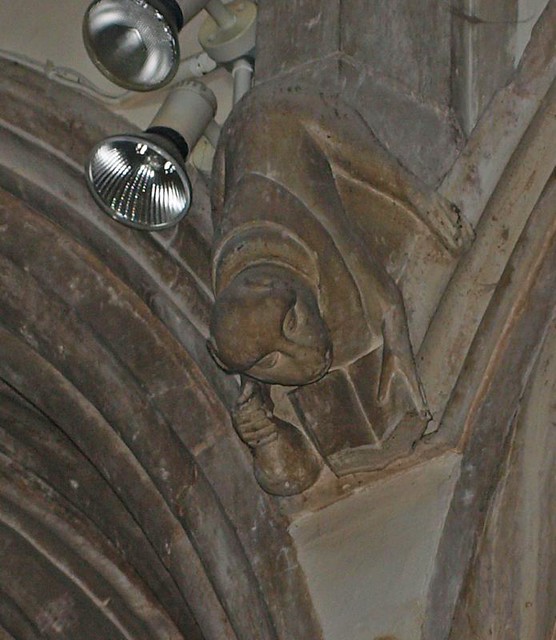SS PETER AND PAUL. The S side appears from the High Street across the churchyard; flint with random stone, an oddly mottled effect. It is not specially long and the tower is not specially high. It is embattled throughout, with chequerboard patterning in the S porch and nave battlements. The earliest part of the church is the chancel with a tall C13 lancet window in the N wall. Otherwise most of what is visible is C15 to C16, except for the tower whose arch to the nave is clearly of early C14 date. The tower has angle buttresses and a SE stair-turret higher than the tower battlements. The broad spacious nave has N and S aisles of six bays with unusual piers which have four attached shafts and in the diagonals thin fillets between hollows. They were renewed in the restoration of 1880-2 (by Bodley), the originals going to Long Marston. The capitals and arches remained. The shafts are continued in the clerestory zone by stone shafts on figures of animals, and these shafts support the old roof. The clerestory windows are of three lights, simple Perp, as are the aisle windows, except the larger ones at the E ends of the aisles. - STAINED GLASS by Kempe, S chancel windows 1886 and 1890, several others of the 90s. - PLATE. Chalice, 1565; two large Flagons and Breadholder, 1713; Breadholder, 1723. - MONUMENTS. The monument to Sir William Gore d. 1707 and his wife is very sumptuous. It proudly faces the porch and is the first thing that strikes the visitor to the church. The sculptor may be Nost. Sir William, in the robes of a Lord Mayor of London, and Lady Gore lie comfortably on the concave sides of the plinth of a big urn against an elaborate pedimented back architecture. - John Gore d. 1763, a dainty epitaph of varied pale marbles with a small medallion against an obelisk; two putti outside the flanking pilasters. - W. Kay d. 1838, by J. Browne, with a big seated female figure.
Tring. Heads should be held high and eyes raised in this small town on the Buckinghamshire border, which has had a market for 600 years and was known as Treung to King Alfred. There is little of beauty in the small houses crowding the winding streets, but in the midst of old and new rises the massive tower of a fine church, and over all are the hills, with Tring Park of 300 acres surrounded by some of the loveliest woods in this countryside so rich in woods. Some of these woods have been bought by the County Council. There are many beeches, and in the beautiful park, which we may walk through, are splendid avenues. The great house has little to remind us of the house in which Nell Gwynn is said to have stayed, the old walls having been encased in red brick, and a top storey been added. The stables are said to have been designed by Christopher Wren.
The Rothschilds have done much for Tring from their home in the park. At one of its fine iron gates is a timbered lodge and a little row of gabled dwellings. Near by is a charming row of timbered houses where the estate workers live when their work is done. Here, too, is the Zoological Museum which Lord Rothschild bequeathed to the British Museum in 1938, with a section for students and galleries crowded with thousands of exhibits for all to enjoy. Beginning with a cottage in which Lord Rothschild housed his marvellous collection of insects, the buildings now cover over half an acre of ground space, accommodating enormous collections on which Lord Rothschild is said to have spent half a million pounds; it includes animals, reptiles, fishes, birds, and two million butterfllies and moths. Attached to the museum is a library of thousands of volumes.
The striking church has a haphazard patchwork of flint and stone in its walls, and great battlements, some of them chequered. Under the battlcments are grotesques and faces. Except for Norman masonry, which may remain at the east end of the south aisle, the oldest part of the church is the 13th-century north wall of the chancel. The chancel itself was partly rebuilt in the 16th century, but it has a 15th-century arch dividing it from the nave. The tower, with a corner stair turret and a vaulted ceiling, is 14th and 15th century. The clerestory and the arches of the nave arcades are also 15th century, but the clustered pillars are 19th, the original being now at Long Marston.
There are 14 old figures on brackets at the ends of the beams of the nave roof, perhaps the disciples with Paul and Barnabas. The shafts below them rest on stone corbels between the arches of the arcades, carved with a fox running off with a goose, a monkey with a book and a bottle, a griffin eating a man in armour, a chained bear, an animal eating a woman, and animals fighting. The old rood stairs lead to the gallery of a modern screen. There is an Elizabethan chalice. The peal of bells has one of 1624, and there is a Jacobean carved chest, with two older ones of iron guarding records dating back to 1566. These throw light on the ancestral family of George Washington, for here was buried in 1655 Amphillis, widow of Lawrence Washington, who lies at Maldon in Essex. Her son Lawrence was baptised in this church. Two years after her death her elder son John Washington emigrated to America, and his great-grandson was the famous George. Four golden angels guard the altar, and on the reredos, shining with gold and colour, are scenes of the Crucifixion and the Resurrection, the conversion of Paul, and Paul preaching.
Good Sir William Gore, once Lord Mayor of London, is here with his wife, a little pompous and self-satisfied, in a monument of 1707. Below them, in 13th-century simplicity, lie a stone coffin lid and a few old worn tiles. A marble memorial has the portrait of Edward Pope, a doctor in Tring for sixty years.
The Rothschilds have done much for Tring from their home in the park. At one of its fine iron gates is a timbered lodge and a little row of gabled dwellings. Near by is a charming row of timbered houses where the estate workers live when their work is done. Here, too, is the Zoological Museum which Lord Rothschild bequeathed to the British Museum in 1938, with a section for students and galleries crowded with thousands of exhibits for all to enjoy. Beginning with a cottage in which Lord Rothschild housed his marvellous collection of insects, the buildings now cover over half an acre of ground space, accommodating enormous collections on which Lord Rothschild is said to have spent half a million pounds; it includes animals, reptiles, fishes, birds, and two million butterfllies and moths. Attached to the museum is a library of thousands of volumes.
The striking church has a haphazard patchwork of flint and stone in its walls, and great battlements, some of them chequered. Under the battlcments are grotesques and faces. Except for Norman masonry, which may remain at the east end of the south aisle, the oldest part of the church is the 13th-century north wall of the chancel. The chancel itself was partly rebuilt in the 16th century, but it has a 15th-century arch dividing it from the nave. The tower, with a corner stair turret and a vaulted ceiling, is 14th and 15th century. The clerestory and the arches of the nave arcades are also 15th century, but the clustered pillars are 19th, the original being now at Long Marston.
There are 14 old figures on brackets at the ends of the beams of the nave roof, perhaps the disciples with Paul and Barnabas. The shafts below them rest on stone corbels between the arches of the arcades, carved with a fox running off with a goose, a monkey with a book and a bottle, a griffin eating a man in armour, a chained bear, an animal eating a woman, and animals fighting. The old rood stairs lead to the gallery of a modern screen. There is an Elizabethan chalice. The peal of bells has one of 1624, and there is a Jacobean carved chest, with two older ones of iron guarding records dating back to 1566. These throw light on the ancestral family of George Washington, for here was buried in 1655 Amphillis, widow of Lawrence Washington, who lies at Maldon in Essex. Her son Lawrence was baptised in this church. Two years after her death her elder son John Washington emigrated to America, and his great-grandson was the famous George. Four golden angels guard the altar, and on the reredos, shining with gold and colour, are scenes of the Crucifixion and the Resurrection, the conversion of Paul, and Paul preaching.
Good Sir William Gore, once Lord Mayor of London, is here with his wife, a little pompous and self-satisfied, in a monument of 1707. Below them, in 13th-century simplicity, lie a stone coffin lid and a few old worn tiles. A marble memorial has the portrait of Edward Pope, a doctor in Tring for sixty years.



No comments:
Post a Comment